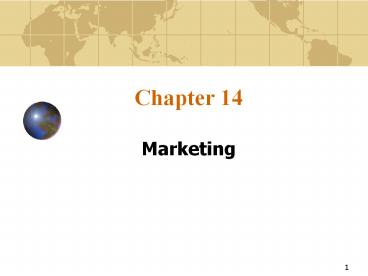Marketing - PowerPoint PPT Presentation
Title:
Marketing
Description:
Marketing. 2. Learning Objectives. Suggest how markets for international ... Market-differentiated pricing is based on demand-oriented strategy making it ... – PowerPoint PPT presentation
Number of Views:66
Avg rating:3.0/5.0
Title: Marketing
1
Chapter 14
- Marketing
2
Learning Objectives
- Suggest how markets for international
expansion can be selected, their demand
assessed, and appropriate strategies for
their development devised. - Describe how environmental differences
generate new challenges for the international
marketing manager. - Compare and contrast the merits of
standardization versus localization strategies
for country markets and of regional versus global
market efforts. - Discuss market-specific and global challenges
facing the marketing functions product, price,
distribution, and promotion within both the
traditional and e-business dimensions.
3
Marketing
- A look at
Target Market Selection
Marketing Management
4
Identification and Screening
- Preliminary Screening
- Estimating Market Potentials by Product Type
- Estimating Sales Potential for Companys Product
- Identifying Segments in Target Market
5
Preliminary Screening
- This process must rely chiefly on secondary data
for country-specific factors as well as product
and industry specific factors.
6
Estimating Market Potential
- The international marketer needs to assess the
size of existing markets and forecast the size of
future markets. - The marketer uses both quantitative and
qualitative techniques for assessment.
7
Estimating Sales Potential
- Collect product and market specific data
- Competition
- Market
- Consumers
- Product
- Channel structure
8
Identifying Segments
- Individuals and organizations vary in their
wants, resources, geographical locations, buying
attitudes, and buying practices.
9
Concentration Versus DiversificationMajor
alternatives for choosing an expansion policy
- Concentration on a small number of markets.
- Diversification is growth in a relatively large
number of markets in early stages.
10
Marketing Management
- Standardization
- The extent to which elements of the marketing mix
should be standardized. - Adaptation
- Marketers may consider every situation
independently, or rely on decision-support
systems to aid in program adaptation.
11
Product PolicyThe Core of the Firms Operations
- Goods
- Services
12
Factors in Product Adaptation
- Regional, Country, or Local Characteristics.
- Governments hold stringent requirements.
- Consider nontariff barriers.
- Competitive offerings may provide a baseline
for resource measurement. - Economic development must be accounted for.
- Customer preferences must be considered.
- Consider economic status of users.
- Consideration of geography.
- Purchase patterns must be considered.
13
Product Characteristics
- Product characteristics are the inherent features
of the product offering.
14
Company Considerations
- Resources
- Cost of adapting
- Organization
- Market Opportunity
- Profitability
- Is It Worth It?
15
Pricing Policy
- The only element in the marketing mix that is
revenue generating. - Export Pricing
- Foreign Market Pricing
- Price Coordination
- Intracompany Pricing
16
Export PricingStrategies
- Standard worldwide pricing is based on average
unit costs of fixed, variable, and export-related
costs. - Dual pricing differentiates between domestic and
export prices. - Market-differentiated pricing is based on
demand-oriented strategy making it more
consistent with the marketing concept.
17
Foreign Market Pricing
- Determined By
- Corporate Objectives.
- Costs.
- Consumer Behavior and Market Conditions.
- Market Structure.
- Environmental Constraints.
18
Price Coordination
- Standard worldwide pricing may be mostly
theoretical. - Significant price gaps lead to the emergence of
gray markets.
19
Intracompany Pricing
- The pricing of sales to members of the corporate
family.
20
Distribution Policy
- Channels of distribution provide the essential
links that connect producers and customers.
21
Channel DesignDetermined by the 11 C-Factors
- Cost
- Coverage
- Control
- Continuity
- Communication
- Customers
- Culture
- Competition
- Company
- Character
- Capital
22
E-Commerce
- Is forecast to grow at a compound annual rate of
50 percent within 5 years. - Western Europe has most growth.
- Governments work to come to terms with security,
privacy, and access to the Internet.
23
Promotional Policy
- Advertising
- Personal Selling
- Sales Promotion
- Publicity































